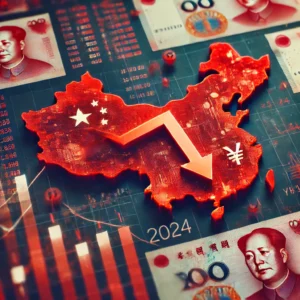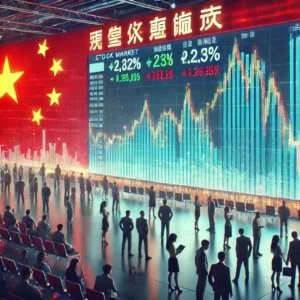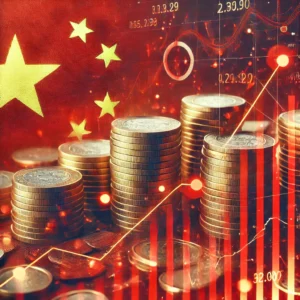
China has approved a debt relief package valued at an estimated $1.4 trillion. This major financial initiative aims to support China’s slowing economy by refinancing local government debt, addressing “hidden debt” risks, and stabilizing the property market. The package represents one of the largest recent efforts by the Chinese government to manage economic challenges and preserve stability in a volatile financial landscape.
In this article, we’ll break down the factors behind China’s decision to implement such a large-scale debt measure, the structure and specific objectives of this relief plan, and its implications for China’s economy, local governments, and the global market.
China’s Current Economic Situation

Over the last few decades, China has been among the fastest-growing economies in the world. Its rapid development brought millions out of poverty, turned cities into global economic hubs, and elevated China as a leading world power. However, recent years have presented unique challenges. Economic growth rates have slowed, debt levels have increased, and the property sector—a core pillar of China’s GDP—has faced significant struggles. To understand China’s decision, let’s delve into the factors affecting its economy.
1. Rising Debt Levels
The Chinese economy has accumulated considerable debt, especially at the local government level. Over the years, local governments borrowed heavily to fund infrastructure projects and stimulate economic growth in their regions. However, much of this borrowing was conducted through shadow banking channels, creating what is known as “hidden debt.” As debt levels increased, so did the financial strain on local governments, affecting their ability to fund essential projects and manage local economies effectively.
2. Property Market Decline
Real estate has long been a major contributor to China’s GDP. However, the property market has recently been characterized by falling prices, reduced sales, and halted projects due to financing challenges faced by real estate developers. Many local governments, which derive significant revenue from land sales, have seen revenue shrink, affecting their ability to meet debt obligations. Stabilizing the property sector has, therefore, become an essential part of China’s economic strategy.
3. Global Economic Pressures
China’s economic challenges are not solely domestic. Trade tensions, particularly with the United States, and slower global demand have impacted Chinese exports. This reduction in demand has contributed to slower economic growth. Meanwhile, geopolitical factors have influenced China’s position on the global stage, making economic stability a top priority.
Overview of China’s $1.4 Trillion Debt Relief Plan

The $1.4 trillion debt relief package is structured as a three-year plan to address local government debt, provide much-needed financial stability, and stimulate the economy. Here’s a closer look at the components of this plan:
Special Sovereign Bonds
One of the central aspects of this debt relief package is the issuance of special sovereign bonds. These bonds are a tool for raising funds that can be allocated toward economic development, particularly in sectors like infrastructure and regional development. Infrastructure investment has historically been a significant driver of China’s economic growth, creating jobs and increasing regional connectivity.
Local Government Bonds
Another key element of the debt package is the issuance of local government bonds. These bonds are designed to help local governments manage their debt more transparently and sustainably. Through these bonds, local governments can raise capital to refinance their existing debts and invest in projects that stimulate local economic activity. By shifting from off-balance-sheet, hidden debt to regulated bonds, China hopes to enhance financial transparency and reduce the risks associated with unmonitored borrowing.
Support for the Property Sector
Recognizing the importance of the property sector in its economy, China has earmarked part of the debt package for property market stabilization. This support is intended to prevent further declines in property values, address issues with stalled projects, and provide a buffer for real estate companies facing financial difficulties. A stable property sector is critical not only for economic growth but also for maintaining consumer confidence and social stability.
Understanding Hidden Debt: A Key Focus of China’s Plan
“Hidden debt” refers to off-balance-sheet liabilities accrued by local governments, often through financing channels not officially recorded or regulated by the central government. These channels, often referred to as shadow banking, include non-traditional lenders and investments that do not appear on government balance sheets. While this form of borrowing provided a quick solution for local governments in the past, it also led to significant financial risks.
China’s debt package aims to address hidden debt by providing a pathway for local governments to refinance these liabilities transparently. By moving hidden debt onto the balance sheet, the government can better monitor and manage it, ensuring that financial risks are minimized and debt remains at sustainable levels.
The Necessity of China’s Economic Stimulus Package
With mounting economic pressures and the threat of financial instability, China’s debt relief package is a timely and necessary intervention. But what are the specific objectives China hopes to achieve with this stimulus, and why is it so critical at this moment?
1. Stabilizing Local Government Finances
Local governments in China play a significant role in the country’s economic management. They are responsible for many public services, infrastructure projects, and local economic development initiatives. However, with high debt burdens, many local governments have faced financial strain, making it difficult to maintain these services and fund new projects. By refinancing this debt, the relief package aims to stabilize local government finances, allowing them to continue supporting regional economies.
2. Encouraging Economic Activity and Investment
China’s debt package is not only about refinancing debt; it’s also intended to stimulate economic activity. By providing funding for infrastructure projects, the package can create jobs, attract investment, and encourage consumption. Special sovereign bonds, for instance, can fund large-scale projects that generate economic returns, such as transportation networks, energy infrastructure, and digital transformation initiatives. These projects, in turn, can attract both domestic and foreign investors, creating a ripple effect that boosts overall economic activity.
3. Supporting the Property Sector
The property market’s influence on China’s economy cannot be overstated. In addition to contributing directly to GDP, the property sector is linked to various other industries, including construction, manufacturing, and finance. By stabilizing the property sector, China hopes to prevent further economic declines in these related industries and maintain social stability by addressing issues with stalled projects and declining property values.
Potential Effects of China’s Debt Package on the Economy
The debt relief package is expected to have several significant effects on China’s economy, with both immediate and long-term implications. Here’s what we can anticipate in terms of outcomes:
1. Immediate Economic Stability
By refinancing local government debt, the package will provide immediate relief to financially strained regions, allowing them to continue essential services and infrastructure projects. This immediate infusion of capital can boost short-term economic stability, creating a more favorable environment for growth.
2. Long-Term Debt Management and Financial Transparency
The package’s focus on addressing hidden debt through regulated channels will enhance financial transparency, allowing China to manage its debt levels more sustainably. Transparent debt management is essential for preventing financial crises, as it enables the government to monitor potential risks and take preemptive actions if necessary.
3. Increased Domestic Demand
Stabilizing the property market and supporting local governments can help boost domestic demand, which is essential for China’s long-term economic growth. With more job opportunities, better infrastructure, and a stable housing market, consumer confidence can rise, encouraging spending and investment in local economies.
Implications for the Global Economy

China is one of the world’s largest economies, and its financial health has far-reaching implications. A stable and growing Chinese economy can benefit global markets by increasing demand for commodities, boosting trade, and contributing to overall market stability. Here are some of the ways China’s debt package could impact the global economy:
1. Commodity Demand and Prices
As China undertakes infrastructure projects and revitalizes its economy, demand for commodities like steel, copper, and oil is likely to rise. This increased demand can drive up commodity prices, benefiting commodity-exporting countries, particularly in regions like Latin America, Africa, and Australia.
2. Global Market Stability
China’s debt package can also contribute to global financial stability. When China’s economy is stable, it reduces the risk of economic disruptions that could impact global markets. A stable Chinese economy can support steady trade flows, benefiting countries with close economic ties to China.
3. Potential Impact on Inflation
Increased demand from China can have mixed effects on global inflation. While commodity prices may rise, China’s ability to export affordable goods can help mitigate inflationary pressures in importing countries.
Long-Term Challenges and Considerations
While the debt package is a positive step for China, it may not be a comprehensive solution to all of the country’s economic challenges. The package addresses immediate financial stability concerns, but long-term economic growth will require additional reforms and structural changes.
1. Managing Debt Levels
One of China’s biggest challenges will be managing its debt levels sustainably. The debt package shifts some liabilities onto the balance sheet, but long-term solutions will require careful management of new debt and ongoing efforts to reduce reliance on borrowing.
2. Economic Diversification
China’s economy is heavily reliant on the property sector and exports, which can make it vulnerable to market fluctuations. To ensure long-term stability, China may need to diversify its economy by fostering growth in other sectors, such as technology, clean energy, and services.
3. Maintaining Social Stability
Social stability is a core concern for the Chinese government. Economic policies that improve job opportunities, raise income levels, and ensure access to affordable housing can help maintain social stability, which is crucial for China’s political and economic landscape.
Key Takeaways from China’s Debt Relief Package
China’s $1.4 trillion debt package is a bold move to address economic challenges and stabilize the nation’s financial system. Here are some key takeaways:
-
Addressing Local Government Debt: The package provides much-needed relief for local governments, enabling them to continue supporting regional economies.
-
Enhancing Financial Transparency: By addressing hidden debt, China is promoting a more transparent and sustainable approach to debt management.
-
Stabilizing the Property Sector: Support for the property market can help prevent further economic declines and maintain consumer confidence.
-
Global Economic Implications: China’s economic stability has far-reaching impacts, from commodity prices to global trade.
In conclusion, while the debt relief package is a positive step, it represents just one piece of China’s broader economic strategy. Long-term economic growth will require continued efforts to manage debt levels, diversify the economy, and address structural challenges. The package is a clear indication of China’s commitment to stabilizing its economy and maintaining its position as a leading global power.
Visit our other website: https://synergypublish.com



